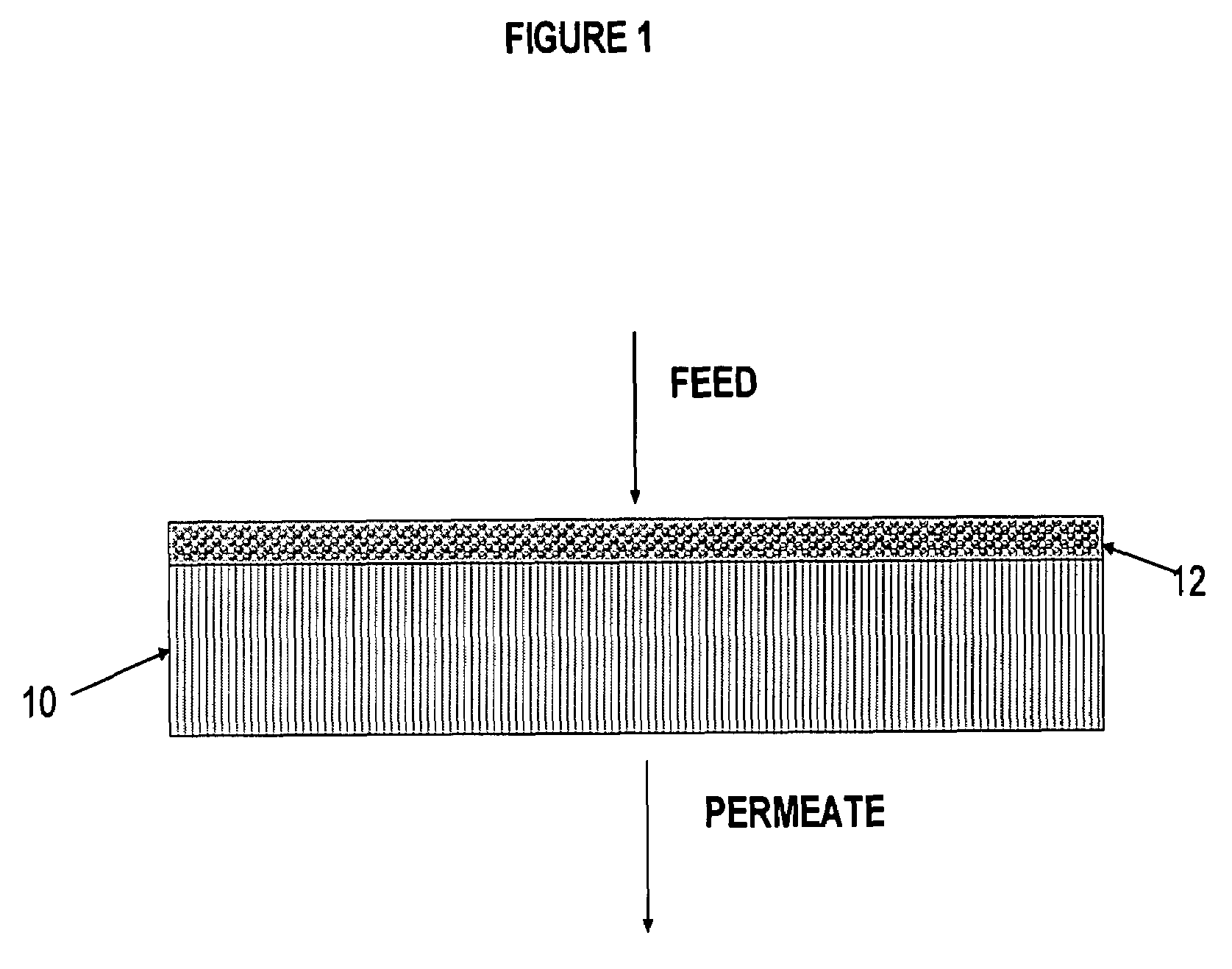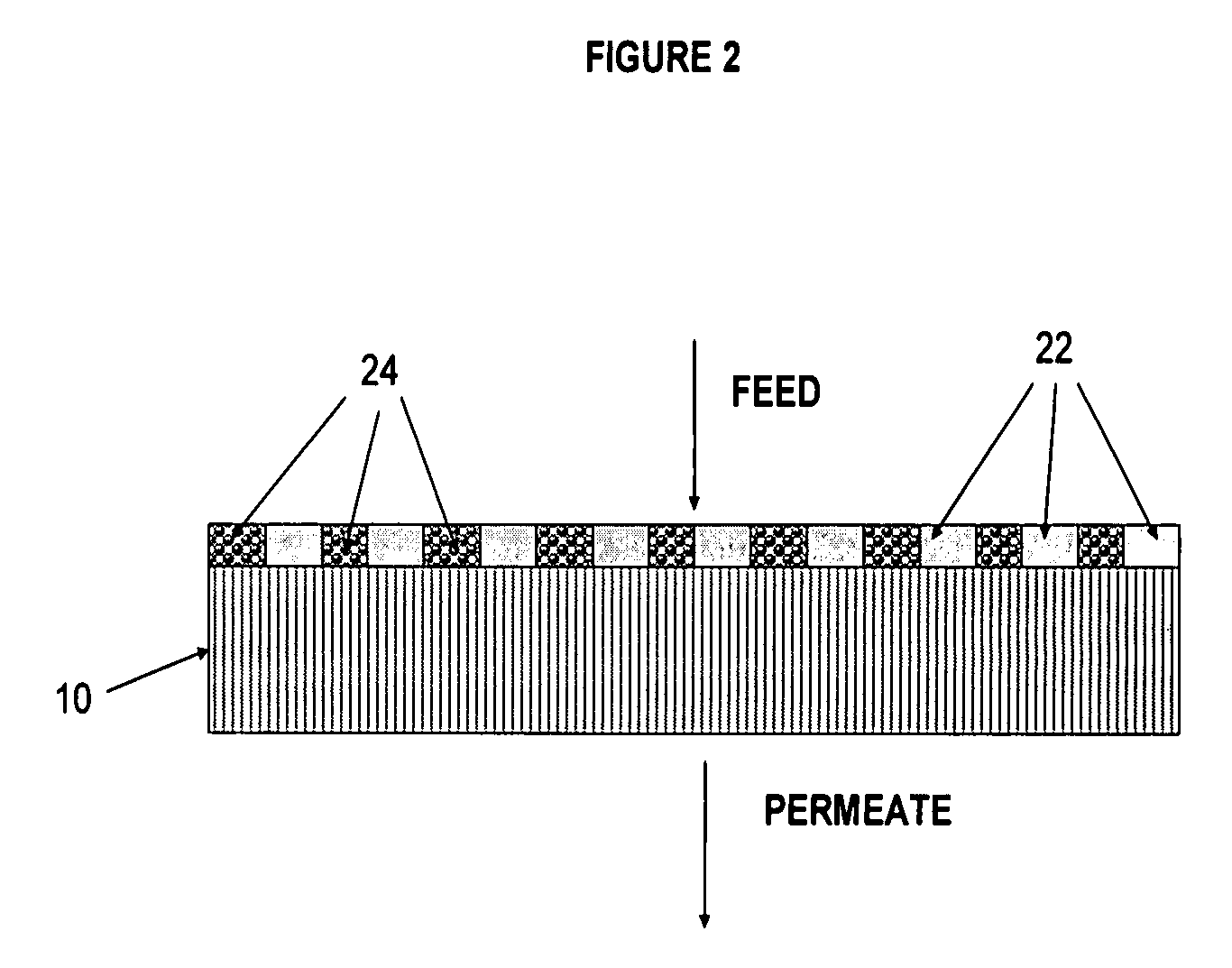Polymer membrane for separating aromatic and aliphatic compounds
a polymer membrane and aromatic and aliphatic compound technology, applied in the direction of filtration separation, separation process, osmosis/dialysis, etc., can solve the problems of high operational and maintenance personnel costs, high installation and operation costs of conventional separation processes such as distillation and solvent extraction, and achieve improved membrane physical integrity and separation characteristics.
- Summary
- Abstract
- Description
- Claims
- Application Information
AI Technical Summary
Benefits of technology
Problems solved by technology
Method used
Image
Examples
example 1
PEI-DECO-PEA 2000
[0053]Diepoxide crosslinked / esterified polyimide-aliphatic polyester copolymers have been synthesized from an oligomeric aliphatic polyester diol, an anhydride, a diamine, and a diepoxide. To illustrate the synthesis and composition of this “base” PEI copolymer, a diepoxycyclooctane crosslinked / esterified polyimide-polyadipate copolymer (diepoxycyclooctane polyethylene imide [PEI]) membrane was used. In the synthesis, 5 g (0.0025 moles) of polyethyleneadipate (PEA) diol (2000 g / mole) is reacted with 1.08 g (0.005 moles) of pyromellitic dianhydride (PMDA) to make a prepolymer in the end-capping step (165° C. / 6.5 hours). 25 g of dimethylformamide (DMF) was added. The temperature was decreased to 70° C. The prepolymer was dissolved in a suitable solvent such as dimethylformamide. 0.67 g (0.0025 moles) of 4,4′-methylene bis(2-chloroaniline) (MOCA) is subsequently added (dissolved in 5g DMF). In the DMF solution, one mole of the prepolymer was reacted with one mole of MO...
example 2
PHTI-DECO-PEA 2000
[0055]The synthesis presented in Example 1 was modified to produce a membrane according to this invention.
[0056]Diepoxide crosslinked / esterified polyimide-aliphatic polyester copolymers have been synthesized from an oligomeric aliphatic polyester diol, an anhydride, a diamine, and a diepoxide or mixtures thereof. 5 g (0.0025 moles) of polyethyleneadipate (PEA) diol (2000 g / mole) was reacted with 2.22 g (0.005 moles) of 4,4′-(hexafluoroisopropylidene)diphthalic anhydride (HPDA) to make a prepolymer in the end-capping step (165° C. / 7.0 hours). 20 g of dimethylformamide (DMF) was added. The temperature was decreased to 70° C. The prepolymer was dissolved in a suitable solvent such as dimethylformamide. 0.41 g (0.0025 moles) of 2,3,5,6-tetramethyl-1,4-phenylene diamine (TMPA) was subsequently added (dissolved in 5 g DMF). In the DMF solution, one mole of the prepolymer reacted with one mole of MOCA to make a copolymer containing polyamic acid hard segment and PEA soft ...
example 3
[0058]The membrane produced in Examples 1, 2, and 3 were evaluated. The thickness of the membrane polymer coatings were about 10 microns to about 15 microns. Discs coupons of 4.7625 cm (1-⅞″) diameter were cut from the cured sheets for evaluation. Two discs were placed face to face to increase membrane thickness. The membranes were supported on a very fine flat stainless steel screen and sealed to the membrane holder with a teflon O-ring. The membrane holder was maintained at the desired temperature in a thermostated oven. The effective area of the membrane when evaluated was 9.5 cm2. Membrane coupons were evaluated using a model gasoline feed having the following nominal composition (by wt): 10% 2,2,4-trimethylpentane (isooctane), 40% n-heptane, 20% toluene, 10% n-octane, 10% mesitylene, and 10% n-decane. The feed was preheated to the desired temperature and flowed over the membrane at 3.6 liters per hour. Typical temperatures ranged from 80 to 140° C. A vacuum of 2 mmHg was mainta...
PUM
| Property | Measurement | Unit |
|---|---|---|
| Glass transition temperature | aaaaa | aaaaa |
| Glass transition temperature | aaaaa | aaaaa |
| Glass transition temperature | aaaaa | aaaaa |
Abstract
Description
Claims
Application Information
 Login to View More
Login to View More - R&D
- Intellectual Property
- Life Sciences
- Materials
- Tech Scout
- Unparalleled Data Quality
- Higher Quality Content
- 60% Fewer Hallucinations
Browse by: Latest US Patents, China's latest patents, Technical Efficacy Thesaurus, Application Domain, Technology Topic, Popular Technical Reports.
© 2025 PatSnap. All rights reserved.Legal|Privacy policy|Modern Slavery Act Transparency Statement|Sitemap|About US| Contact US: help@patsnap.com



